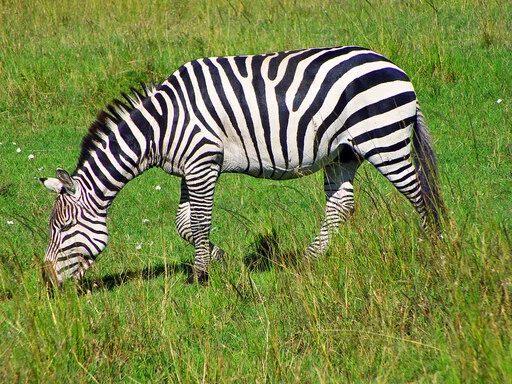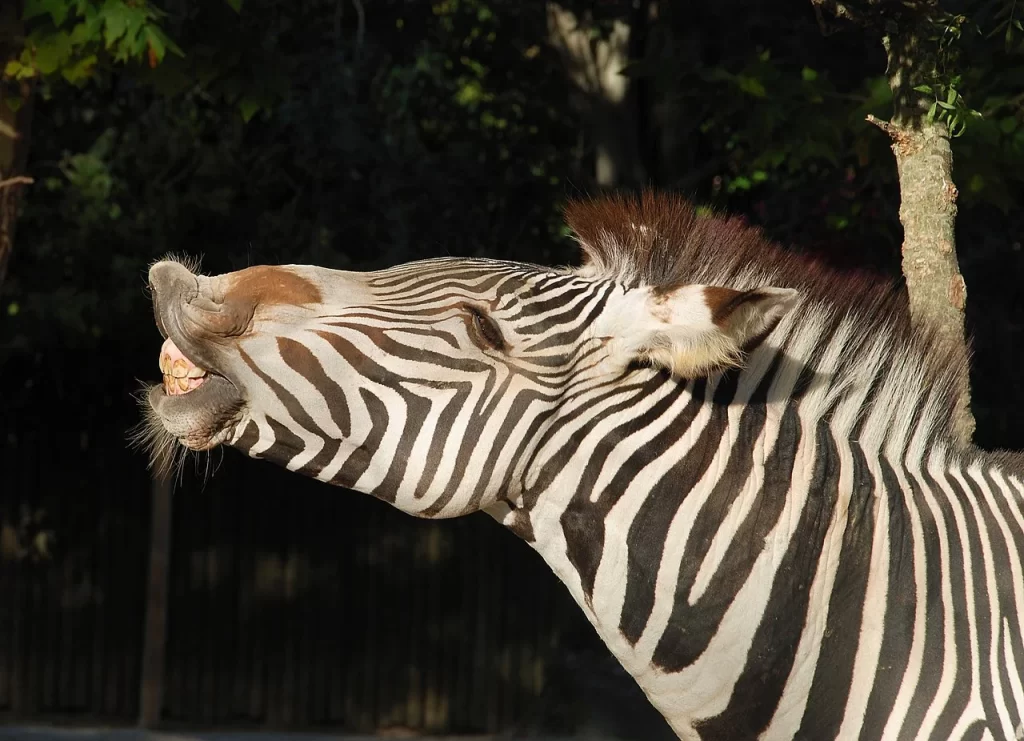A zebra is an African equine or horse-like mammal easily differentiated by its black and white stripes, which are as distinct among each zebra as the fingerprints. Zebras are native to Africa and there are three species: the mountain zebra, the plains zebra and the Grevy’s zebra. With asses and horses, they have a common genus Equus and are the only three groups falling under the Equidae family. Zebras are single hoofed, live in herds and are yet to be fully tamed.
Zebras are herbivores, feeding on grass, which comprises over 90% of their diet. They prefer the long grass, drawing the line between them and most other grass-eaters. They also feed on shrubs, branches, and stems of small trees. Zebras in the zoo are mostly fed on hay and alfalfa. However, they also eat special pellets as vitamins and are sometimes given carrots and apples as treats

A zebra’s stomach is adapted to digest and pick nutrients from long, less nutritious grass in the savannah, be it dry or green. They however find it hard to digest the shorter grass with higher amounts of nutrients and proteins, which the other grazers thrive in. Zebras, when circumstances force them, stripe tree barks for food. This article tells us more about where zebras live, how they get food and water and how long they live. Keep reading for more.
Where Do Zebras Live?
Zebras are common in east and southern Africa regions. They prefer the plain areas, thriving in Africa’s treeless savanna grasslands but also in sparse woodlands with rough terrain. You would probably spot a zebra in Kenya, Tanzania, South Africa, Namibia, Uganda and Rwanda, among other African countries.
Though zebras are highly water-dependent, you would not find them in the rainforests or in wetlands. They also do not live in deserts. Gradually, their habitats have significantly shrunk, making the striped animals extinct in Lesotho and Burundi.
Currently, zebras are categorized as ‘near threatened’, with about 600,000 plains zebra individuals existing in Africa’s sub-Saharan regions. IUCN’s Red List of Threatened Species indicates that the mountain zebra is categorized as vulnerable, the Grevy’s zebra population is endangered while the plains zebra species is not endangered.
How Do Zebras Get Their Food?

Zebras are herbivorous mammals and they mostly feed by grazing on grass. However, at times, they also feed on small amounts of leaves, flowers and stems of the small bushes in the savanna.
Zebras spend over 18 hours a day feeding, especially due to the fact that the long grass they prefer is less nutritious. They need much of it for survival, unlike the other grass grazers. They generally prefer fresh, green grass due to its higher levels of nutrients. Commonly however, zebras would eat old, dry grass, which the other grazers do not eat, and their digestive system would obtain the required nutrients from it.
This makes their food readily available due to the very minimal competition from the other grazers. This makes them very essential in the African ecosystem because whenever they feed on the dry grass, fresh one grows, providing food for the other large herbivores. A zebra’s teeth, which grow throughout its entire life, are also adapted to the harsh environment; the sharp incisors cut the fresh or dry grass and plant shoots while the molars chew it fine.
How Much Do Zebras Eat A Day
As a general rule, zebras are comfortable with eating less grass when it is fresh because it gives them sufficient nutrients. However, they need more of the dry grass because it contains less nutrients.
In the zoos, zebras eat only once a day. The digestive system of zebras is far more efficient than that of other grazers and can extract nutrients even from the grass containing small amounts of it.
So, the amount a zebra eats per day highly depends on the kind of food available to them; fresh, green grass or old, dry grass. As well, zebras spend over eighteen hours in the wild eating. In most cases, wild animals can eat food weighing up-to 2.5% of their own weight.
How Long Can Zebras Go Without Water?
Though zebras do not live in the wetlands and the rainforests, they remain highly dependent on water. They always need to live near rivers, water holes and other water sources all through their lives. This is however a challenge and an inevitable threat in the wild.
As a general rule, zebras should drink water on a daily basis. Mother zebras with their foals need to drink water at least two times a day, taking more than four liters (over a gallon) of water per drink. When circumstances force them, zebras have to go for around three days without water.
The plain zebras comfortably survive in habitats with more amounts of water. This is unlike wild asses, who can survive in habitats with almost no water sources, However, the Grevy’s zebra species lies in-between the two habitats. Grevy’s zebras can go up-to five days without a single sip of water.
How Long Does a Zebra Live?

On average, a zebra in the wild will stay breathing for around 20 years, before age weighs it down. In the zoo, zebras are more energetic, well-catered for and comfortable, enabling them to remain alive for up to 40 years, double their friends’ age in the wild.
The aspect of the age a zebra can live is however very dependent on many factors. In the wild, zebras are prey to lions, cheetahs and leopards. This means that for a zebra to live its full age, it must have battled all its predators and escaped death from them. Some of the zebras also die from the pains inflicted on them by their predators, days after the attack.
Zebras are heavy mammals, just like horses. The mountain zebra can weigh somewhere between 240 kgs and 370 kgs while an adult mare of a Cape mountain subspecies would weigh around 234 kgs and the stallion, between 250 and 260 kgs. The plain zebras can weigh up-to 400 kgs.
